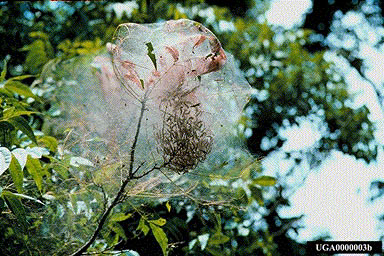Fall webworm
Hyphantria cunea
Natural History

Webbing from fall webworm
Photo credit: G. K. Douce - University of Georgia
The fall webworm (Hyphantria cunea) feeds on many hardwood trees throughout the United States but is not considered a major pest in most areas. The web or tents that the caterpillars build in trees is considered unattractive by many people. In Florida, the fall webworm is common and can cause serious damage to commercial pecan groves.
In the spring, the female webworm moths lay egg masses with 400 to 500 eggs on the underside of leaves in the host tree. The female covers the egg mass with white hairs. After one to two weeks, the larvae hatch and immediately start to eat surrounding leaves and begin to build their web-like nests in the trees.
For four to eight weeks, the larvae continue to devour leaves and expand their webs. Eventually, the larvae spin a cocoon, usually on the ground near the tree, where they stay throughout the winter. This cycle can be repeated several times in one growing season. The following spring the moths emerge and mate to start the cycle over again.
